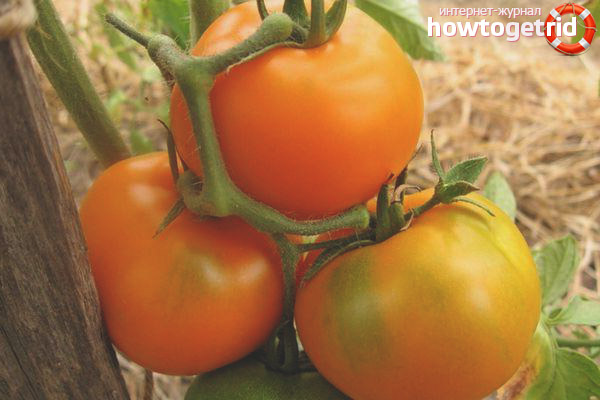The content of the article
The state register does not include such a large number of tomato varieties, including hybrid varieties, which would include a minimum of acids that are aggressive for the gastrointestinal tract and a maximum of sugars and dry substances. One of these types of tomatoes - a fairly recent development of breeders - is a variety that produces large fruits, which is called the "Monastic meal". It is characterized by a fairly sweet taste, it does not have an acid irritating digestive system.
Grade characteristics
The monastic meal is a hybrid variety. The plant is determinant. If you grow a tomato in unheated greenhouses or in temporary shelters under a film, the bushes grow up to 150 centimeters in height. On open beds, the height of the plant exceeds 100 centimeters quite rarely.
The formation of the plant stem does not occur, on the contrary, a large number of full stepsons appear at the base of the plant. If you ensure their quality care, the yield of vegetable crops will increase significantly.
Variety Monastic meal is considered mid-season. The first crop can be harvested 90-110 days after the seed was planted for seedlings. The plant is successfully grown both in greenhouse conditions and on open ground. Suitable for landing in spacious containers. It is necessary to take into account the fact that the variety is not very resistant to the main diseases characteristic of tomatoes.
The variety is medium-yielding - from each square meter you can collect up to 5.5 kilograms of ripe fruits.
Crop description
Tomatoes have a smooth, rounded shape, slightly flattened laterally. The weight of each fruit reaches from 140 to 180 grams. But with good nutrition of the plant, combined with favorable weather conditions, the weight of one tomato can reach up to 400 grams.
Each fruit contains at least six chambers with seeds, while they do not have much fluid. The same applies to pulp, which contains at least 60 percent solids.
Fruits of this variety have a short shelf life. If you store them in the refrigerator, they do not lose their taste and presentation for one and a half months. At the same time, it is better to place them in one layer, inserting waxed paper, or wrapping it around each tomato. The fruits are fairly well transported.
Application area
Since tomatoes at the Monastic Meal are distinguished by increased density and excellent taste characteristics, they are most often consumed fresh, salads and snacks are prepared from them.
During heat treatment, fruit cracking occurs, while the pulp falls apart into small pieces, for this reason they are not suitable for canning. However, such tomatoes can be used to make sauces, ketchups, pastes.
Positive and negative qualities
The main advantage of tomatoes The monastery meal is that the fruits that it gives are large and have a great taste. In addition, the plant:
- unpretentious to growing conditions - lighting and heat;
- moderately resistant to pathogens and fungi.
The negative qualities of the variety include the fact that tomatoes are prone to cracking with a sharp increase in soil moisture. For this reason, cultivation in greenhouses is recommended, where regulation of this indicator is possible. When growing on unprotected soil, it is desirable to contain the plant in large containers - if necessary, they can be carried indoors.
Growing Features
- Variety Monastic meal is grown from seedlings. Sow seeds should be 50 days before the transfer of the bushes to a permanent place.
- When placing seedlings in the garden, it is necessary to ensure that no more than four bushes are located on one square meter.
- As the bushes grow, they should be tied to a support. The lower part must be regularly stepsoned, leaving the strongest stepson to form a plant in two stems.
- Plantings should be regularly (once or twice a week) watered and fed using organic or mineral fertilizers.
To ensure that all fruits are guaranteed to be tied, it should be from the moment the plant begins to bloom, it should be treated with growth stimulants.
Video: Monastyrskaya Tomatoes











Submit